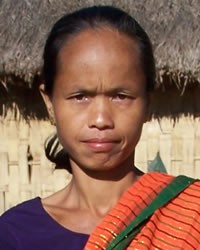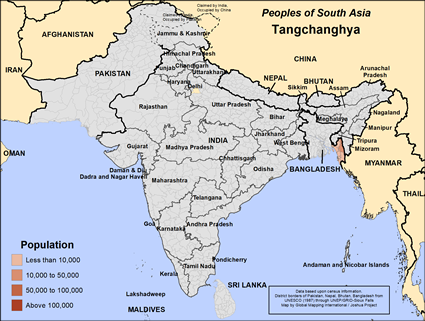Tangchanghya in Bangladesh

Photo Source:
Gerald Roberts
|

Map Source:
People Group data: Omid. Map geography: UNESCO / GMI. Map Design: Joshua Project
|
| People Name: | Tangchanghya |
| Country: | Bangladesh |
| 10/40 Window: | Yes |
| Population: | 68,000 |
| World Population: | 70,000 |
| Primary Language: | Tangchangya |
| Primary Religion: | Buddhism |
| Christian Adherents: | 13.37 % |
| Evangelicals: | 0.00 % |
| Scripture: | Translation Needed |
| Ministry Resources: | No |
| Jesus Film: | No |
| Audio Recordings: | Yes |
| People Cluster: | South Asia Buddhist |
| Affinity Bloc: | South Asian Peoples |
| Progress Level: |
|
Introduction / History
The Tangchanghya live in the Chittagong Hills Tract district of southeastern Bangladesh. Tropical hills and mountains in this area sharply contrast the low plains of the rest of the country. The Tangchanghya remain closely related to tribal people closely related to the Chakma; they are a branch of the Chakma.
The Tangchanghya people speak the Indo-Aryan language of Tangchanghya with similar linguistic connections to Bengali. Because the Tangchanghya assimilate more often into mainstream Bangladeshi culture than many other tribal groups, the people speak Bengali as a second language.
Over the last century, several powers have governed the Tangchanghya people group within Bangladesh, including Britain until 1947, then afterward by the final nation of Pakistan until 1971. Despite the freedom, a flood of Bengali immigrants from the severely overcrowded plains has caused the Tangchanghya to become a minority people group in their own land.
What Are Their Lives Like?
The Tangchanghya primarily earn their income as farmers. The people group's traditional method includes slash-and-burn, which generally was used in the highest parts of the hills. After cutting down small tracts of forest, the people burned the debris in order to plant a variety of crops. The Bangladeshi government long discouraged slash-and-burn agriculture techniques; therefore, many Tangchanghya now use irrigation and plow cultivation in the low hills and lowland areas.
Rice remains the primary crop, although the Tangchanghya also plants cotton, cucumbers, pumpkins, yams and maize, as well as a wide variety of tropical fruits. The dao remains the people group's main agricultural tool, which resembles in appearance as a long knife similar to a machete. The dao is used in nearly every aspect of life, from a variety of tasks, from building houses to harvesting crops. Common livestock includes cattle, water buffalo, pigs, goats and sheep. Nearly all Tangchanghya keep dogs.
The Tangchanghya people build homes constructed of wooden or bamboo poles that reach about six feet above the ground. Bamboo, used to make the walls, also aids as a source for the construction of roofs. Rarely do the people construct their homes with tin roofs.
The Tangchanghya men work in the fields while the women cook, care for children, clean the house, draw water, weave and wash clothes. The women also help the men in the fields, and the men assist in caring for children.
The Tangchanya's have nuclear families. Although the people group accepts polygamy (life with multiple spouses), they seldom practice it. Parents typically arrange their children's marriages, but the opinions of the young man and the young woman receive consideration.
What Are Their Beliefs?
Like most of the tribal people groups of the Chittagong Hill Tracts, the Tangchanghya practice Buddhism, adhering to the expectations from the Theravada branch. But elements of Hinduism and animism (a belief that non-living objects possess spirits) exist within their religious practices. The Tangchanghya believe many spirit beings either help or harm humans. The people believe that exorcists and priests (shamans) mediate between people and the spirit world through incantations, charms and spirit possession.
What Are Their Needs?
The Tangchanghya remain mostly illiterate and suffer from poor health care as an influx of Bengali settlers threatens their land.
Prayer Points
Ask the Lord of the harvest to send forth laborers to minister life to the Tangchanghya.
Ask the Holy Spirit to inspire Tangchanghya family heads, so they possess a desire for finding and articulating spiritual truth so others will know the truth of Jesus Christ.
Pray additionally that God will give Tangchanghya believers the boldness to disciple their people in the ways of Christ.
Intercede for God to work with providing additional resources among the Tangchanghya.